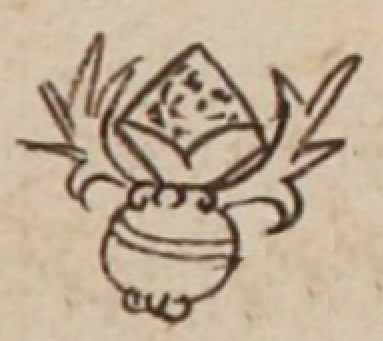Techin (Verg7r)
This black-line drawing of the compound glyph for the personal name Techin (perhaps "Stone Enclosure" or "Stony Chinamitl," attested here as a man’s name) shows a vertical stone (tetl), with the usual, curling ends and stripes across the middle. Above the stone is a square with some designs (curving lines and dots) that could point to a maize cob from an agricultural parcel (chinamitl). On either side of this cob are what may be flames, and so perhaps the chinamitl is on fire (tlachinolli), which would provide another "chin" element.
Stephanie Wood
The analysis is tentative for this compound, which has potential logograms and phonograms contributing to the reading. Therefore, the translations are also very tentative. But the potential semantic reading of corn cob is supported by Cen Icuic example from the Codex Vergara (folio 17 verso), below. In turn, the Cen Icuic from 10 recto of that manuscript clarifies the reading of the corn cob on 17v.
Stephanie Wood
po. techin
Pedro Techin
Stephanie Wood
1539
Jeff Haskett-Wood
piedras, flamas, chinampas, fuegos, incendios, maíz, milpa

te(tl), stone, https://nahuatl.wired-humanities.org/content/tetl-0
chin(amitl), a reed or cane fence or enclosure, https://nahuatl.wired-humanities.org/content/chinamitl
Muro de Piedra, o Sementera Pedregosa (?)
Codex Vergara, folio 7r, https://gallica.bnf.fr/ark:/12148/btv1b84528032/f21.item
The non-commercial reuse of images from the Bibliothèque nationale de France is free as long as the user is in compliance with the legislation in force and provides the citation: “Source gallica.bnf.fr / Bibliothèque nationale de France” or “Source gallica.bnf.fr / BnF.” We would also appreciate a citation to the Visual Lexicon of Aztec Hieroglyphs, https://aztecglyphs.wired-humanities.org/.








